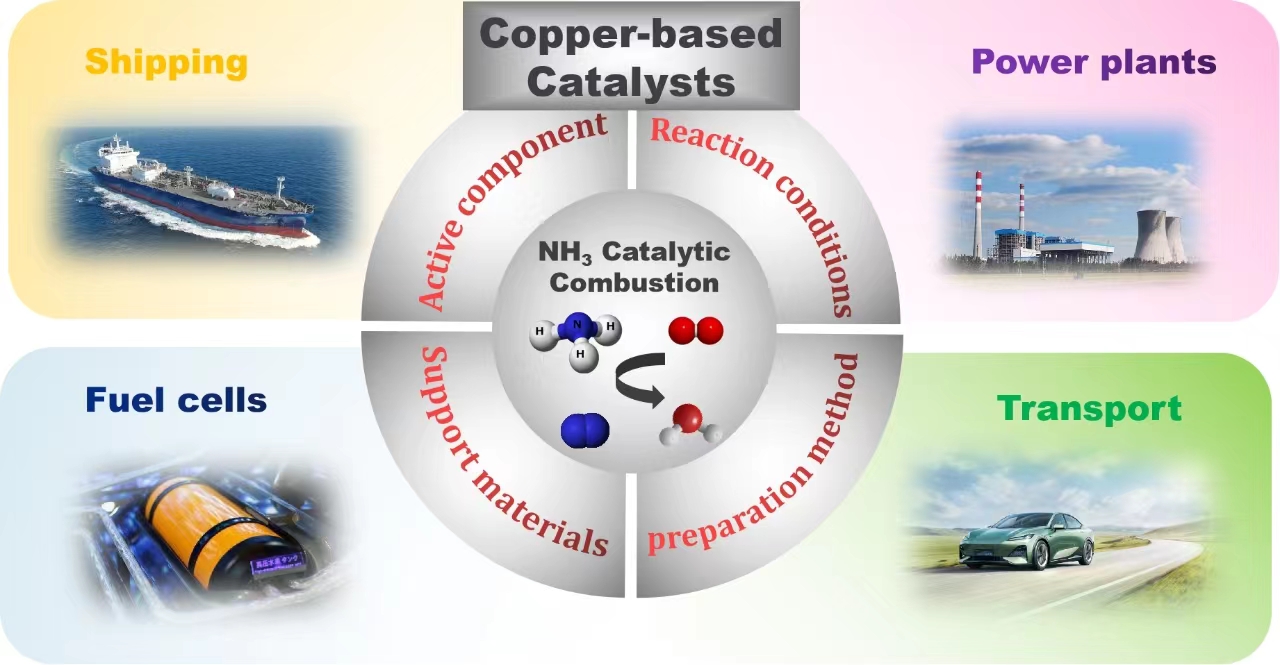 PDF(59045 KB)
PDF(59045 KB)


Application of Copper-Based Catalysts for the Selective Catalytic Combustion of Ammonia
Qian Zhang, Runze Tao, Yu Huang, Houzhang Tan, Baochong Cui
Prog Chem ›› 2024, Vol. 36 ›› Issue (5) : 783-797.
 PDF(59045 KB)
PDF(59045 KB)
 PDF(59045 KB)
PDF(59045 KB)
Application of Copper-Based Catalysts for the Selective Catalytic Combustion of Ammonia
Ammonia is a promising new energy carrier that has the potential to replace traditional fossil fuels due to its high calorific value,CO2emission-free and renewable properties,and low storage and transportation costs.However,ammonia combustion faces several challenges,such as high NOxemission,slow combustion rate,and ignition difficulties.To address these challenges,selective catalytic combustion is an efficient and promising way that can decrease combustion temperature,enhance combustion stability,improve fuel conversion rate and reduce NOxemission while requiring less auxiliary fuel and consuming less energy.Copper-based catalysts are cost-effective and they are demonstrated to exhibit excellent performance in ammonia catalytic combustion with high N2selectivity.In this review,the reaction experimental setup and primary mechanisms,namely NH-HNO,N2H4and i-SCR pathways,are presented first;then,the recent research progress on copper-based supported catalysts for ammonia combustion,including the effect of preparation methods,types of support materials,metal-support interactions,and Cu-based single or multiple active components on catalytic performance are reviewed in detail.Finally,the review is concluded by summarizing the research achievements,current drawbacks and proposing the future developments 。
1 Introduction
2 Catalytic NH3combustion experimental setup and mechanisms
2.1 Experimental setup and performance indicators
2.2 Mechanism and research techniques
3 Copper-based catalysts for NH3combustion
3.1 The effect of preparation methods on performance
3.2 The effect of support on performance
3.3 The effect of active component on performance
4 Conclusion and outlook

new energy carrier / ammonia / copper based catalysts / selective catalytic combustion / NOx emission
| [1] |
( 彭觅, 吕斌, 张纯, 黄斌. 城市发展研究, 2010, 17(7): 6.)
|
| [2] |
National Bureau of Statistics of China. China Statistical Yearbook. Beijing: China Statistics Press, 2021.
( 中华人民共和国国家统计局. 中国统计年鉴. 北京: 中国统计出版社, 2021.)
|
| [3] |
( 严刚, 郑逸璇, 王雪松, 李冰, 何捷, 邵朱强, 李永亮, 吴立新, 丁焰, 徐伟, 李新, 蔡博峰, 陈潇君, 宋晓晖, 王倩, 雷宇, 王金南. 环境科学研究, 2022, 35(2): 309.)
|
| [4] |
( 谢和平, 任世华, 谢亚辰, 焦小淼. 煤炭学报, 2021, 46(7): 2197.)
|
| [5] |
( 崔夏瑜. 能源与节能, 2022, (5): 33.)
|
| [6] |
|
| [7] |
|
| [8] |
( 谭厚章, 周上坤, 杨文俊, 崔保崇, 邓双辉, 王金华, 王学斌. 中国电机工程学报, 2023, 1: 181.)
|
| [9] |
( 夏鑫, 蔺建民, 李妍, 陶志平. 化工进展, 2022, 41(5): 2332.)
|
| [10] |
( 李海洋. 化学工程, 2021, 49(11): 73.)
|
| [11] |
( 赵志强. 武汉理工大学博士学位论文, 2013.)
|
| [12] |
( 王月姑, 吴崇君, 郑淞生, 陈锦, 何嵩, 王兆林. 可再生能源, 2019, 37(7): 949.)
|
| [13] |
( 李育磊, 刘玮, 董斌琦, 夏定国. 储能科学与技术, 2022, 11(9): 2891.)
|
| [14] |
|
| [15] |
|
| [16] |
|
| [17] |
|
| [18] |
|
| [19] |
|
| [20] |
|
| [21] |
|
| [22] |
|
| [23] |
|
| [24] |
|
| [25] |
|
| [26] |
|
| [27] |
|
| [28] |
|
| [29] |
|
| [30] |
|
| [31] |
|
| [32] |
|
| [33] |
|
| [34] |
|
| [35] |
|
| [36] |
|
| [37] |
|
| [38] |
|
| [39] |
|
| [40] |
|
| [41] |
|
| [42] |
|
| [43] |
|
| [44] |
|
| [45] |
|
| [46] |
|
| [47] |
|
| [48] |
|
| [49] |
|
| [50] |
|
| [51] |
|
| [52] |
|
| [53] |
|
| [54] |
|
| [55] |
|
| [56] |
|
| [57] |
|
| [58] |
( 赵雪纯. 山东化工, 2022, 51(10): 72.)
|
| [59] |
|
| [60] |
|
| [61] |
|
| [62] |
|
| [63] |
|
| [64] |
|
| [65] |
|
| [66] |
|
| [67] |
( 张黎明, 秦永宁, 沈美庆, 齐晓周, 宋健. 燃烧科学与技术, 2000, 1: 70.)
|
| [68] |
|
| [69] |
|
| [70] |
|
| [71] |
|
| [72] |
|
| [73] |
|
| [74] |
|
| [75] |
|
| [76] |
|
| [77] |
( 吴成强, 张长斌, 张昱, 贺泓, 杨敏. 中国环境科学, 2004, 24(6): 670.)
|
| [78] |
|
| [79] |
|
| [80] |
|
| [81] |
|
| [82] |
|
| [83] |
|
| [84] |
|
| [85] |
|
/
| 〈 |
|
〉 |